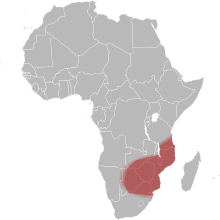Mozambique spitting cobra
| Mozambique spitting cobra | ||||||||||||
|---|---|---|---|---|---|---|---|---|---|---|---|---|

Mozambique spitting cobra ( Naja mossambica ) |
||||||||||||
| Systematics | ||||||||||||
|
||||||||||||
| Scientific name | ||||||||||||
| Well mossambica | ||||||||||||
| Peters , 1854 |
The Mozambique spitting cobra ( Naja mossambica ) is a snake from Africa. It belongs to the genus of real cobras from the family of poisonous snakes .
description
The snake is gray, olive or yellow-brown on top. Some or all of the scales have black borders. On the belly side it is colored salmon-pink to yellowish-purple. The ventral scales are speckled or lined with brown or black. The species becomes around 1 meter long. However, a specimen 1.54 meters long was also found in Durban .
distribution
It is the most common cobra found in the African savannah . The distribution area includes northeastern South Africa (the provinces of Limpopo , Mpumalanga , Gauteng , KwaZulu-Natal , and the eastern part of northwest ), furthermore the states of Swaziland , Mozambique , Botswana , Zambia , Zimbabwe , southeastern Tanzania and the island of Pemba , the western one and southern Angola and northern Namibia .
Way of life
The diet consists mainly of amphibians , other snakes, birds, eggs, small mammals and the occasional insect.
The female lays 10 to 20 eggs from which young 230 to 250 millimeters in size hatch.
Poisonous effect
The Mozambique spitting cobra is considered one of the most dangerous African snakes. It can stand up to two thirds of its body length and inject its poison in the direction of the supposed enemy. As with other spitting cobras, it is squeezed out of the venom glands and sprayed several meters. The snake mainly aims at the eyes. If the poison gets in the eyes, it can cause temporary or permanent blindness and deter a potential attacker from pursuing the spitting cobra. The venom causes tissue damage after a bite. 94% of the bites occur within human settlements, 82% of the victims are bitten while sleeping.
literature
- WCH Peters : Diagnoses of new Batrachians with an overview of the snakes and lizards collected in Mossambique. Monthly reports of the Royal Prussian Academy of Sciences in Berlin, pp. 614–628, Berlin 1854 (first description)
- William R. Branch: Field guide to the snakes and other reptiles of Southern Africa. Ralph Curtis Publishing, 1989, p. 109. ISBN 978-0-88359-042-3 .
Web links
Individual evidence
- ^ William R. Branch: Field guide to the snakes and other reptiles of Southern Africa. Ralph Curtis Publishing, 1989, p. 109. ISBN 978-0-88359-042-3
- ^ CR Tilbury: Observations on the bite of the Mozambique spitting cobra (Naja mossambica mossambica). South African Med J., 61, 9, pp. 308-320, 1982
